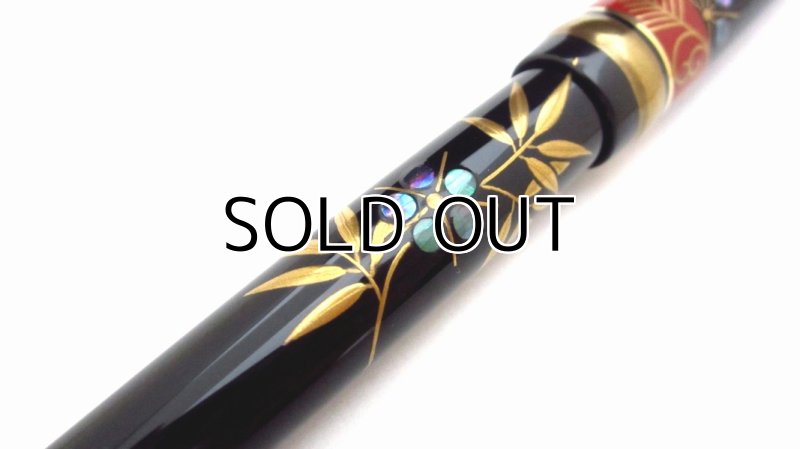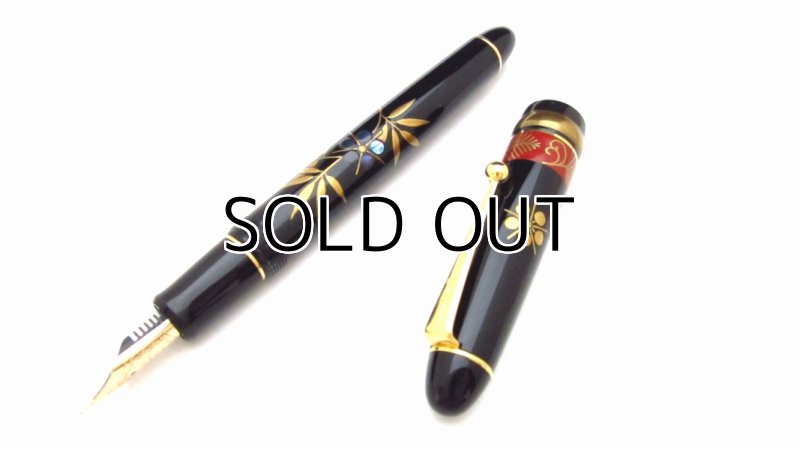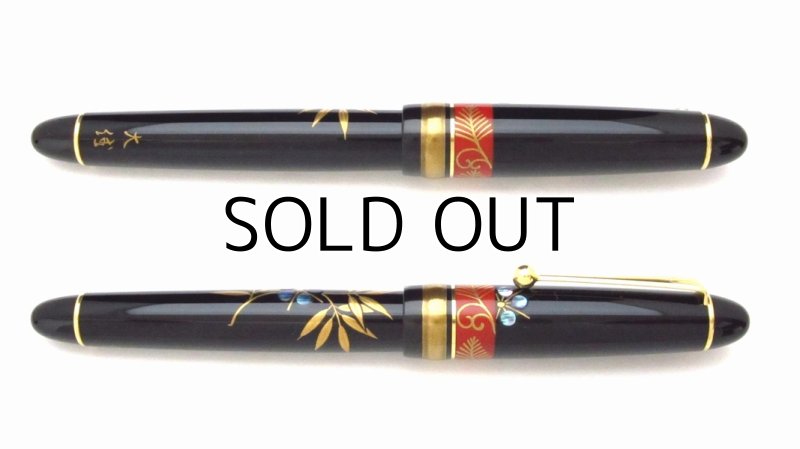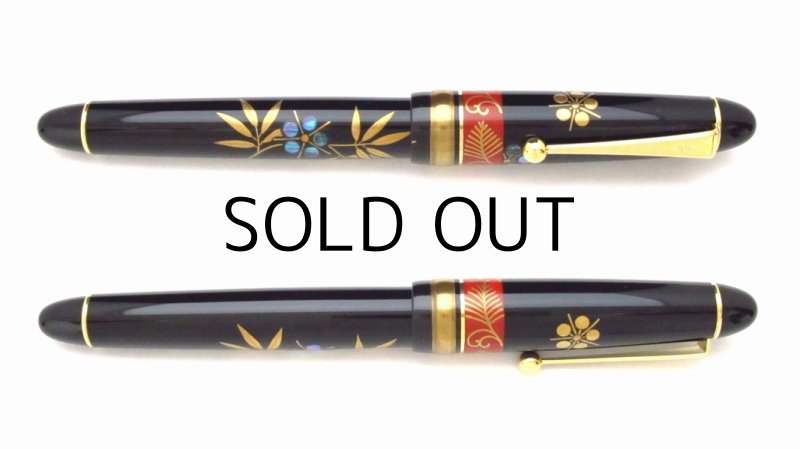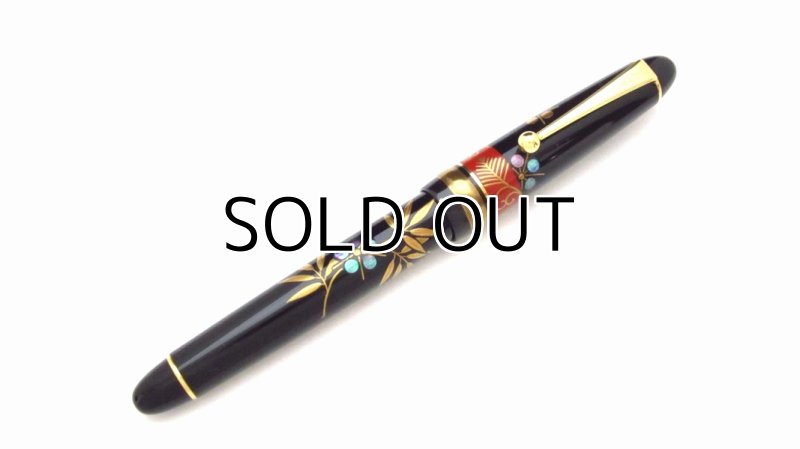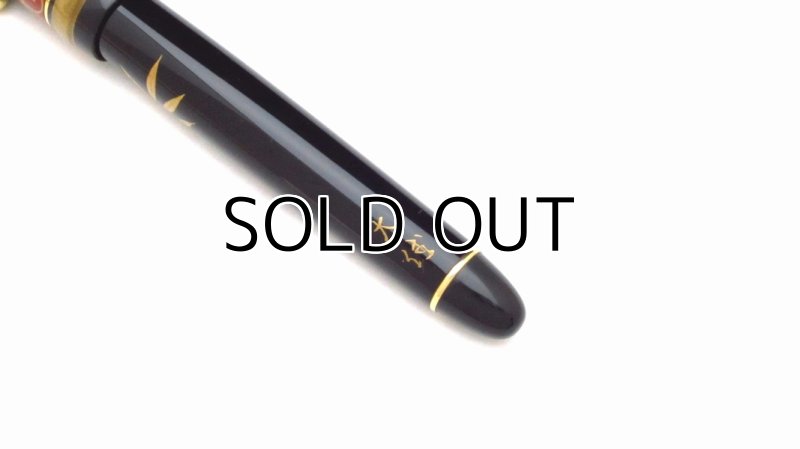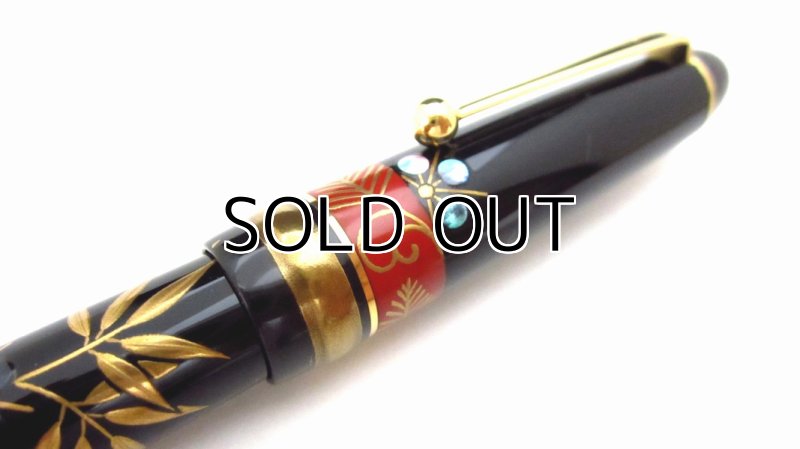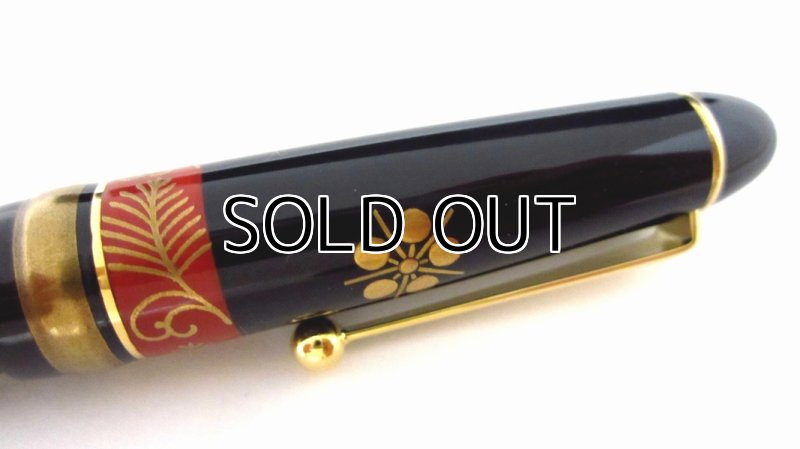AGJ Original Maki-e Fountain Pen #06 "Sho-Chiku-Bai" Sparkling Togidashi Taka Maki-e Kyoto Japan Wa
AGJ Original Maki-e Fountain Pen #06 "Sho-Chiku-Bai" Sparkling Togidashi Taka Maki-e Kyoto Japan Wa
Please contact us from here for the price.
Item Description
This Authentic Goods from Japan's Original Maki-e (makie) Pilot Fountain pen is made by famous Kyoto Maki-e Artisan “Daikai”.
This pen is only one in the world. You can not find it anywhere.
Kyoto Maki-e is the best known Maki-e technique in Japan.
This is the original maki-e fountain pen based on Japanese fountain pen.
[Description]
Name: Shochikubai #6 (Original)
(Pine, Bamboo and Plum trees. This combination is considered to bring good luck in Japan since old times)
Maki-e Artist: DAIKAI
Technique: Togidashi-Taka Maki-e Raden
Origin: Kyoto, Japan
Nib: 14K Gold
Nib size: Medium
Size: 15.7mm(Dia.) x 146mm
Shipping: FREE SHIPPING!
Others: With CON-70 converter
Custom engraving service on AGJ's original Maki-e fountain pens is available for those who wish.
1. The lead time: it takes 10-14 days on top (orders without this service will be usually dispatched in 3-5 days after confirming the payment).
2. The cost: US$100.00.
3. The letters of the name engraved will be engraved in gold just as the signature of the Makie artisans of Original fountain pens.
4. Please send us the sample letters which you wish to engrave on the pen (there could be a case where we are unable to engrave the letters of your choice after consulting with the Makie artisans. Letters can be in Japanese Kanji, Katakana and Hiragana but if you choose Kanji, we will use phonetic symbols).
5. Please indicate the exact position where you wish to have your name engraved (please understand that there could be a case where we may have to change the position of engraving after consulting with the Makie artisans).
*Please contact us should you have any queries regarding custom engraving service.
Techniques:
1. Pine: Gold Arabesque maki-e on red-urushi
1) Paint with red-urushi, dry and polish with charcoal, repeat the process.
2) Give arabesque maki-e on red-urushi.
3) Overlay ( paint raw-urushi, dry and polish)
2. Bamboo: Tsukegaki taka maki-e (thickened with gold)
1) Draw bamboo leaves with Bengala Urushi, sprinkle gold powder, and apply uwazuri-urushi( upper coating), and polish.
2) Repeat the process again to give the thickness.
3. Plum: Tsukegaki taka maki-e + Raden(mother of pearl (using ear-shell))
1) Draw bamboo leaves with Bengala urushi(processed raw urushi mixed with bengala), sprinkle gold powder, and apply uwazuri-urushi (upper coating), and polish.
2) Repeat the process again to give the thickness.
3) Apply Raden technique (mother of pearl) on plums.
Ring part on each fountain pens
1. Applying black-urushi, dry and apply black-urushi again, dry and apply black-urushi once again.
2. Sprinkle gold power
3. Cover with raw-urushi
4. Polish with charcoal
[DAIKAI's Career]
Urushi Lacquer Master : Daikai Uehara’s Career
Year 1950 Born in Kyoto
His father, uncle, grand father and grand-grand father were Urushi Lacquer masters too.
1969 Another Urushi artist“ Masakichi Shima” started teaching Daikai.
1976 Daikai began succeeding to inherit the style of Kyo makie(Maki-e).
1985 Won the Kyoto Chamber of Commerce Award at Kyoto Lacquerware exhibition.
1986 Held Urushi Lacquer exhibition at Kyoto Takashimaya(the largest department store in Japan).
1990 Exhibited at the Arts and Crafts in kyoto.
1991 Became a technical lecturer for the artists at the traditional industry at Kyoto.
1994 Opened his Kyoto Urushi lacquer school.
1995 Invited to display his works at INFA 1995 in Hannover, Germany.
1997 Won the award at the industrial techniques for the crafts in Kyoto.
1999 Held the first Kyoto Urushi lacquer school’s exhibition at Ko-dai temple, Kyoto.
2001 He has held the traditional crafts exhibition every year since 1999.
2008 Held Amber Maki-e and Lacquer works exhibition at Sogo department store.
2009 Held Kyoto Urushi Lacquer exhibition at Takashimaya in Namba, Osaka.
He lives in Kyoto now and teaches many Maki-e artisans Kyoto-Makie technique.
This pen is only one in the world. You can not find it anywhere.
Kyoto Maki-e is the best known Maki-e technique in Japan.
This is the original maki-e fountain pen based on Japanese fountain pen.
[Description]
Name: Shochikubai #6 (Original)
(Pine, Bamboo and Plum trees. This combination is considered to bring good luck in Japan since old times)
Maki-e Artist: DAIKAI
Technique: Togidashi-Taka Maki-e Raden
Origin: Kyoto, Japan
Nib: 14K Gold
Nib size: Medium
Size: 15.7mm(Dia.) x 146mm
Shipping: FREE SHIPPING!
Others: With CON-70 converter
Custom engraving service on AGJ's original Maki-e fountain pens is available for those who wish.
1. The lead time: it takes 10-14 days on top (orders without this service will be usually dispatched in 3-5 days after confirming the payment).
2. The cost: US$100.00.
3. The letters of the name engraved will be engraved in gold just as the signature of the Makie artisans of Original fountain pens.
4. Please send us the sample letters which you wish to engrave on the pen (there could be a case where we are unable to engrave the letters of your choice after consulting with the Makie artisans. Letters can be in Japanese Kanji, Katakana and Hiragana but if you choose Kanji, we will use phonetic symbols).
5. Please indicate the exact position where you wish to have your name engraved (please understand that there could be a case where we may have to change the position of engraving after consulting with the Makie artisans).
*Please contact us should you have any queries regarding custom engraving service.
Techniques:
1. Pine: Gold Arabesque maki-e on red-urushi
1) Paint with red-urushi, dry and polish with charcoal, repeat the process.
2) Give arabesque maki-e on red-urushi.
3) Overlay ( paint raw-urushi, dry and polish)
2. Bamboo: Tsukegaki taka maki-e (thickened with gold)
1) Draw bamboo leaves with Bengala Urushi, sprinkle gold powder, and apply uwazuri-urushi( upper coating), and polish.
2) Repeat the process again to give the thickness.
3. Plum: Tsukegaki taka maki-e + Raden(mother of pearl (using ear-shell))
1) Draw bamboo leaves with Bengala urushi(processed raw urushi mixed with bengala), sprinkle gold powder, and apply uwazuri-urushi (upper coating), and polish.
2) Repeat the process again to give the thickness.
3) Apply Raden technique (mother of pearl) on plums.
Ring part on each fountain pens
1. Applying black-urushi, dry and apply black-urushi again, dry and apply black-urushi once again.
2. Sprinkle gold power
3. Cover with raw-urushi
4. Polish with charcoal
[DAIKAI's Career]
Urushi Lacquer Master : Daikai Uehara’s Career
Year 1950 Born in Kyoto
His father, uncle, grand father and grand-grand father were Urushi Lacquer masters too.
1969 Another Urushi artist“ Masakichi Shima” started teaching Daikai.
1976 Daikai began succeeding to inherit the style of Kyo makie(Maki-e).
1985 Won the Kyoto Chamber of Commerce Award at Kyoto Lacquerware exhibition.
1986 Held Urushi Lacquer exhibition at Kyoto Takashimaya(the largest department store in Japan).
1990 Exhibited at the Arts and Crafts in kyoto.
1991 Became a technical lecturer for the artists at the traditional industry at Kyoto.
1994 Opened his Kyoto Urushi lacquer school.
1995 Invited to display his works at INFA 1995 in Hannover, Germany.
1997 Won the award at the industrial techniques for the crafts in Kyoto.
1999 Held the first Kyoto Urushi lacquer school’s exhibition at Ko-dai temple, Kyoto.
2001 He has held the traditional crafts exhibition every year since 1999.
2008 Held Amber Maki-e and Lacquer works exhibition at Sogo department store.
2009 Held Kyoto Urushi Lacquer exhibition at Takashimaya in Namba, Osaka.
He lives in Kyoto now and teaches many Maki-e artisans Kyoto-Makie technique.
